St Luke's Church, Kentish Town
St Luke's Kentish Town is an active Church of England parish church on Oseney Crescent in Kentish Town, North London, closed from 1991 to 2011 and now hosting a Holy Trinity Brompton church plant. The church has been designated by English Heritage as a Grade II* listed building,[1]
| St Luke's Kentish Town | |
|---|---|
| St Luke's Kentish Town | |
 The nave and tower of St Luke's Kentish Town | |
 St Luke's Kentish Town Location in London | |
| OS grid reference | TQ 295 850 |
| Location | Kentish Town, London NW5 2AT |
| Country | England |
| Denomination | Anglican |
| Website | http://www.slkt.org.uk |
| History | |
| Founded | 1867 |
| Dedication | Saint Luke |
| Dedicated | 1867 |
| Consecrated | 1869 |
| Architecture | |
| Heritage designation | Grade II* |
| Designated | 10 June 1954 |
| Architect(s) | Basil Champneys HMDW Architects |
| Architectural type | Church |
| Style | Victorian |
| Groundbreaking | 1867 |
| Completed | 1869 |
| Specifications | |
| Spire height | 40 metres (131.2 ft) |
| Materials | Red brick with stone dressings, red tile roof |
| Clergy | |
| Vicar(s) | Jon March |
| Curate(s) | Jon Finch |
History
The church was built between 1867 and 1869 using £12,500 compensation provided by the railway company for the demolition of St Luke's Church, Euston Road, along with money from the sale of the church building on the Euston Road.[2] John Johnson had built the church on Euston Road and hoped to be commissioned to design the new church in Kentish Town. However, he was disappointed when he was in fact passed over in favour of the 25-year-old Basil Champneys.[1][3] It was his first church and one of his first buildings. His father, William Weldon Champneys, who commissioned the church, was the vicar of the parish of St Pancras.
The original construction phase included the three east stained glass windows designed by Henry Holiday and made by Heaton, Butler and Bayne. The same company produced the c. 1880-1890 aisle windows of the twelve apostles and the 1891 west window,[1][4] whilst a Willis organ was installed in 1893. Morris & Co. produced four more stained glass windows for the south clerestory in 1910 - two are taken from figures by Edward Burne-Jones and two by John Henry Dearle.
A reredos added in the 1930s and in 1955 the benefice was merged with that of St Paul's Camden Square,[5] an arrangement that lasted until 1987.[6] St Luke's present brass eagle lectern dates to 1882 and originally came from St Paul's, which had been war-damaged. The building closed in 1991 and was handed over to the Churches Conservation Trust, before reopening in 2011 via a pastoral measure naming Revd Jonathan March as the new parish priest. Renovation work by HTB was completed in January 2012 and services have recommenced as of 29 January 2012[7]
Architecture
Exterior
The exterior of the church is largely red brick with stone dressings, and the roof is tiled. The tower with its saddleback gabled roof is in the North German style, with three arcaded openings to the belfry and plate tracery above. The detail of the nave, chancel and aisles is Early English revival.
The nave has four bays with narrow aisles. The chancel is situated beneath the tower. It has a polygonal apse with plate tracery. The west end has three lancet windows, with a plate tracery rose window above. The aisles and clerestory have pointed windows in pairs.[1]
Interior
The walls are of exposed red brick with two bands of stone. The nave arcades have low cylindrical pillars. Between the arches are shafts which support the principal roof timbers. The floor is paved with red and black tiles. From the crossing, there are three steps up to the brick-vaulted chancel and a further six steps up to the sanctuary, which has decorative tiles and sedilia.
Gallery
 Vaulting of the Chancel, featuring the Christmas opening service lighting, 18th Dec 2011
Vaulting of the Chancel, featuring the Christmas opening service lighting, 18th Dec 2011 Facing east in the Nave; the Font in the foreground
Facing east in the Nave; the Font in the foreground Facing west in the Nave
Facing west in the Nave
See also
References
- "Church of St Luke with St Paul, Camden Town", Heritage Gateway website, 2006, retrieved 21 December 2010
- Article on Wanstead United Reformed Church (formerly Congregational Church), Wanstead
- From: 'Additional Churches', Survey of London: volume 24: The parish of St Pancras part 4: King’s Cross Neighbourhood (1952), pp. 140-146. Date accessed: 27 February 2011
- Cherry, Bridget; Nikolaus Pevsner (1998). London 4: North. London: Penguin Books. p. 345. ISBN 0-14-071049-3.
- ORDER IN COUNCIL FOR UNION OF BENEFICE WITH BENEFICE OF ST PAUL, CAMDEN SQUARE, 1955
- ORDER IN COUNCIL FOR DISSOLUTION OF BENEFICE OF ST LUKE, OSENEY CRESCENT WITH ST PAUL, CAMDEN SQUARE AND CREATION OF BENEFICE OF ST LUKE, OSENEY CRESCENT AND BENEFICE OF ST PAUL, CAMDEN SQUARE, 1987
- http://www.htb.org.uk/news/article/curate-jon-march-appointed-vicar-north-london-church